Corrosion/Corrosion Resistance
Atmospheric Corrosion Monitoring
by ACM Type Corrosion Sensor
Principle and Composition of ACM
Quantitative evaluation of the corrosiveness of atmospheric environments is an extremely important issue for life estimation and maintenance control of structures. As factors in the atmospheric environment which influence the corrosion of metals, temperature, humidity, rainfall, airborne salt particles, corrosive gases, etc. may be mentioned.
The ACM (Atmospheric Corrosion Monitor type corrosion sensor (hereinafter, ACM Sensor) was developed by Prof. Emeritus Shigeo Tsujikawa of the University of Tokyo, Director Tadashi Shinohara of the National Institute for Materials Science (NIMS) and Prof. Shin'ichi Motoda of Tokyo University of Marine Science and Technology, and enables direct measurement of the corrosion current of metals, which is generated electrochemically by environmental factors. In other words, direct and quantitative evaluation of corrosion environments is possible by analyzing the output of the ACM sensor.
The following are representative related literature published by the developers.
Related Literature
- Shinohara et al., Japanese Soc. of Corrosion Engineering, Proceedings of the 40th Japan Corrosion Conference, 495 (1993).
- Motoda et al., Zairyo-to-kankyo (Corrosion Engineering), 43, 550 (1994).
- Tsujikawa, Iron and Steel Institute of Japan, Forum on Surface Treatment and Corrosion of Building Materials, Symposium materials 1 (1997).
(NIMS Datasheet Station, Corrosion Research Group website: http://www.nims.go.jp/corrosion/)
JFE-TEC uses ACM Sensors which are authorized by the Japanese Society of Corrosion Engineering and approved by the Corrosion Center of the Society.
Principle
-
If two species of metal (Fe/Ag), which are mutually insulated, are exposed to the atmosphere, a thin water film will form on the surface as a result of rainfall or condensation. When the water film covers the two metals, an electrical cell is formed, and a current passes between the metals. It is possible to measure the corrosiveness of actual atmospheric environments by measuring and analyzing this weak current.
-
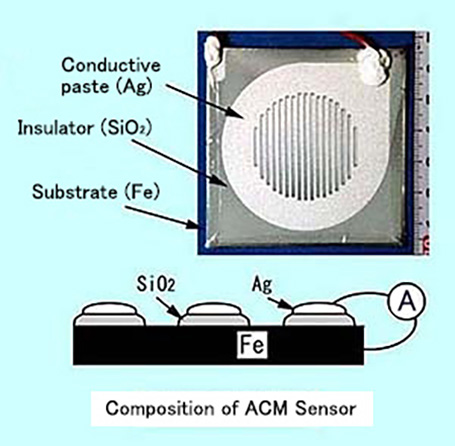
Configuration of Atmospheric Environment Evaluation System
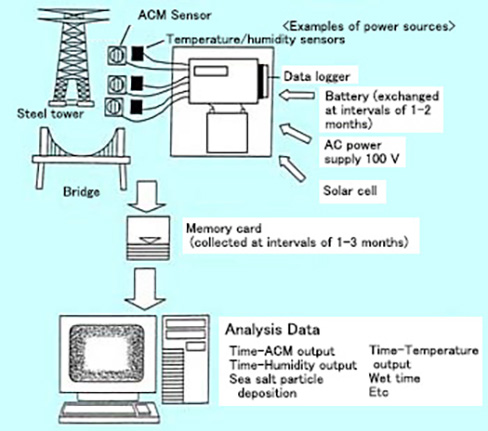
Features of Atmospheric Environment Evaluation System Using ACM Sensor
- Possible to evaluate differences in the corrosiveness of the environments of structures at arbitrary positions, directions and angles.
- Enables real-time measurement at the actual location of the structure.
- Possible to estimate the corrosion rates of carbon steel and Zn-coated steel sheets in their actual environments.
- Possible to evaluate the corrosiveness of atmospheric environments in a short time (several months to 1 year).
- By using the ACM Sensor in combination with temperature and humidity data, it is possible to estimate the rainfall time, wet time and equivalent amount of sea salt deposition at the location where the sensor is installed.
Data Analysis and Evaluation of Environments
The Atmospheric Environment Evaluation System measures the sensor output current I [A] at intervals of 10 minutes. Similarly, the temperature and humidity at the sensor installation location are also measured every 10 minutes. This is the basic data for analysis and evaluation.
Basic Data
Time-Relative humidity
Time-Humidity
Time-ACM Sensor output data
The output of the ACM Sensor is the corrosion current I [A] which flows between the two metals (Fe/Ag) that make up the Sensor. Data analysis is performed based on these values, as required by the purpose of corrosion monitoring.
Primary Analysis
Change over time in ACM Sensor output
Differences in sensor output depending on ACM Sensor installation location
Relationship between rain and humidity and ACM Sensor output.
Daily Average Quantity of Electricity
The ACM Sensor output is the current value I [A] at a certain point in time. The value obtained by integrating the current values for an arbitrary period of time is called the integrated quantity of electricity Q [C] (unit: coulomb), and in particular, the integrated quantity of electricity per day is called the daily average quantity of electricity Q [C/day]. This daily average quantity of electricity Q is an index which is frequently used when evaluating the corrosiveness of atmospheric environments. The above-mentioned relationships are expressed by the following equations:
ACM Sensor output: Current value I [A]
Integrated quantity of electricity Q [C] = ΣI × time [sec]
Daily average quantity of electricity Q [C/day] = Q/Number of days of measurements
Estimation of Corrosion Rate
JFE-TEC has performed ACM monitoring in many locations over a number of years, and has rich databases of the results of analysis of the obtained data. By referring to these databases, it is possible to estimate, from the obtained daily average quantity of electricity Q, the corrosion rates and remaining life of materials in individual atmospheric environments.
Examples of Application of ACM Sensor
Evaluation of Corrosiveness of Actual Environments of Structures
-
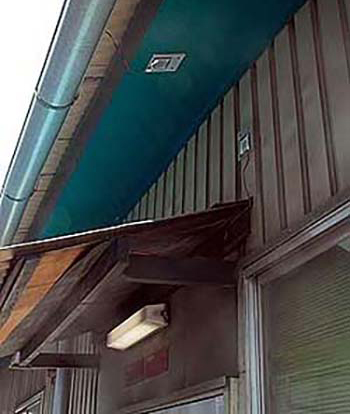
External appearance of ACM Sensors installed
on eaves and on wall surface under eaves -
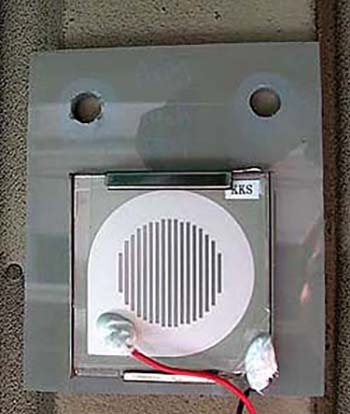
Enlarged view of ACM Sensor installed
on wall surface under eaves -
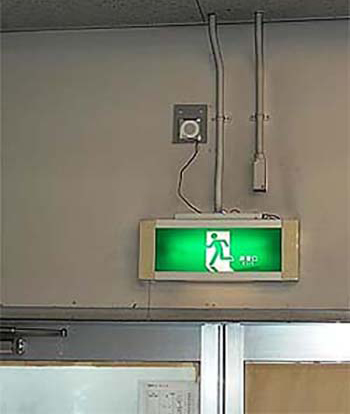
ACM Sensor installed on
indoor wall surface
Comparison Tests with Exposed Materials
-
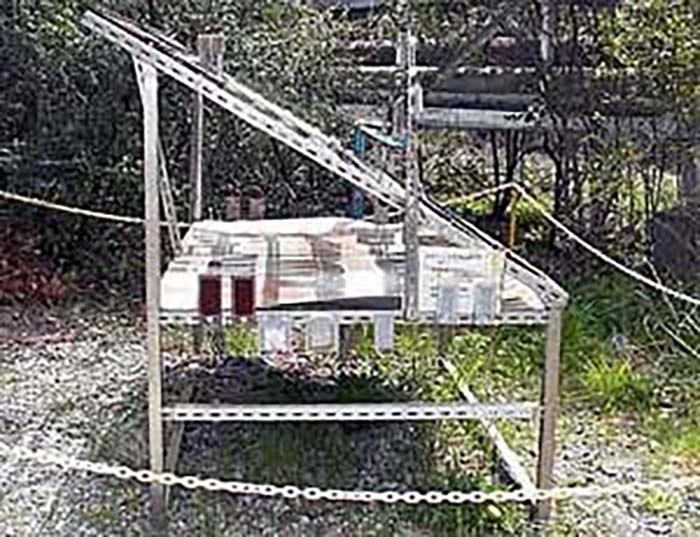
ACM Sensor installed on an exposure test rack -
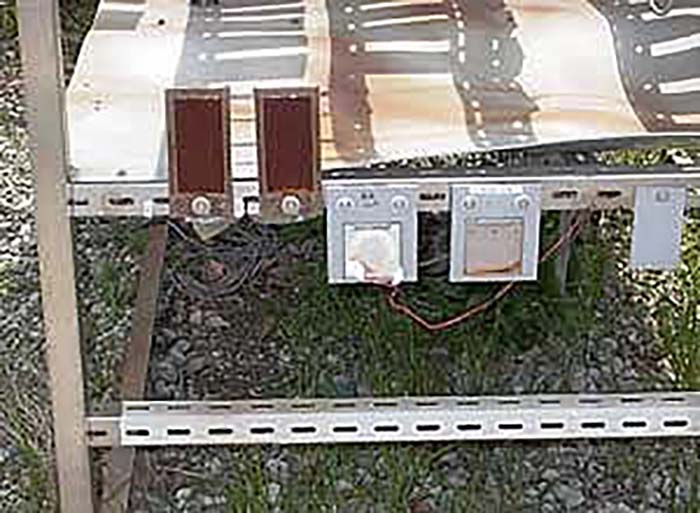
Enlarged view of ACM Sensor installed on the exposure test rack shown above


